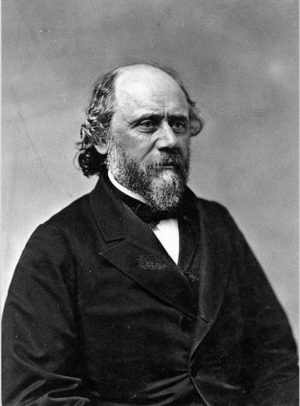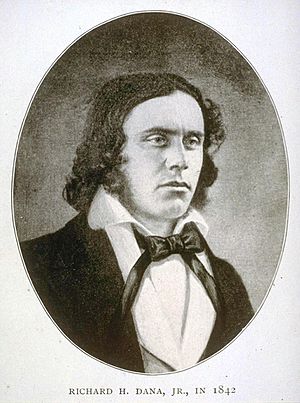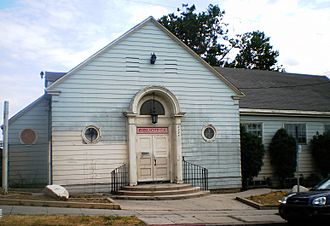Richard Henry Dana Jr. facts for kids
Quick facts for kids
Richard Henry Dana Jr.
|
|
|---|---|

Richard Henry Dana photographed by Asa B. Eaton, c. 1868.
|
|
| United States Attorney for the District of Massachusetts | |
| In office 1861–1866 |
|
| President | Abraham Lincoln |
| Preceded by | Charles L. Woodbury |
| Succeeded by | George Stillman Hillard |
| Personal details | |
| Born | August 1, 1815 Cambridge, Massachusetts, U.S. |
| Died | January 6, 1882 (aged 66) Rome, Italy |
| Political party | Free Soil Republican |
| Other political affiliations |
Independent Republican (1868) |
| Signature | |
Richard Henry Dana Jr. (born August 1, 1815 – died January 6, 1882) was an American lawyer and politician from Massachusetts. He came from a very old family that settled in America long ago. He is famous for writing a classic book called Two Years Before the Mast. Both as a writer and a lawyer, he worked hard to help people who were struggling. This included sailors, people who had escaped slavery, and newly freed people.
Contents
Early Life and School Days
Richard Henry Dana Jr. was born in Cambridge, Massachusetts, on August 1, 1815. His family had lived in America since 1640. His father, Richard Henry Dana Sr., was a well-known poet and writer.
When he was a boy, Dana went to school in Cambridgeport. His teacher, Samuel Barrett, was very strict. He would punish students by hitting them. Once, he almost pulled Dana's ear off! Dana's father complained, and the school stopped this harsh punishment.
In 1825, Dana went to a private school run by Ralph Waldo Emerson. Dana later said Emerson was a "very pleasant instructor." However, he felt Emerson didn't have enough rules to make students study hard.
His Journey and Career
In July 1831, Dana started at Harvard College. In his first year, he supported a student protest. This led to him being suspended for six months. Later, he got measles, which caused problems with his eyesight.
This eye trouble changed his life. Instead of taking a fancy trip to Europe, he decided to become a merchant seaman. This was unusual for someone from his social background. On August 14, 1834, he left Boston on a ship called the Pilgrim. The ship was headed to Alta California, which was part of Mexico at the time.
Life at Sea and a Famous Book
During his voyage, Dana visited many places in California, like Monterey and San Diego. He saw the ship's captain, Frank Thompson, treat sailors very badly, even hitting them. Dana promised himself he would try to make life better for common sailors. The Pilgrim collected animal hides to send back to Boston. Dana spent a lot of time in San Diego, preparing these hides.
Dana wrote about his time in San Diego. He showed kindness towards the Hawaiians who also worked there. He may have felt good about them because he had met Hawaiians in New England.
To get home faster, Dana switched to another ship called the Alert. He wrote a famous account of the trip back around Cape Horn. This journey happened in the middle of the cold Antarctic winter. He described terrible storms and amazing beauty, like huge icebergs. It took weeks to sail against strong winds and storms. Sailors had to climb icy ropes to handle the sails. At one point, Dana had a tooth infection and couldn't work. He also wrote about scurvy, a sickness that affected the crew. The writer Herman Melville said Dana's chapters about Cape Horn were "unmatchable."
Becoming a Lawyer and Helping Others
On September 22, 1836, Dana returned to Massachusetts. He then went to Harvard Law School. He finished in 1837 and became a lawyer in 1840. He chose to specialize in maritime law, which deals with laws of the sea and ships. In 1839, he criticized a judge for giving a light sentence to a captain and mate who had beaten a ship's cook to death.
In 1841, Dana published The Seaman's Friend. This book became a key guide about the legal rights and duties of sailors. He often defended common sailors in court.
During his sea voyages, Dana kept a diary. In 1840, he published a book based on his experiences called Two Years Before the Mast. The phrase "before the mast" means where common sailors lived on a ship, at the front. Officers lived at the back. His writing showed his strong feelings for people who were treated unfairly. Later, during the California Gold Rush, his book became very popular. It was one of the few sources of information about California.
Dana became a leading abolitionist. This meant he was against slavery. In 1848, he helped start the Free Soil Party, which opposed slavery spreading into new U.S. territories. In 1854, he defended Anthony Burns, a person who had escaped slavery, in Boston. He was also part of the Boston Vigilance Committee, a group that helped people who had escaped slavery.
In 1859, Dana traveled to Cuba. He visited Havana, a sugar farm, and other places. He wrote about this trip in his book To Cuba and Back.
Working for the Government
During the American Civil War, Dana worked as a United States Attorney. In a case called the Prize Cases, he successfully argued in the Supreme Court. He said that the President had the power to block ports used by the Confederate states.
After the war, he left his government job. He did not agree with President Andrew Johnson's plans for rebuilding the country after the war. These plans were seen as too easy on former Confederates and not helpful enough for the civil rights of Black people. Dana then went back to working as a private lawyer. From 1867 to 1868, he was a member of the Massachusetts legislature. He also helped the U.S. government in the trial of Confederate President Jefferson Davis. Dana believed Davis had committed treason but thought a jury in Virginia might not convict him.
In 1868, Dana ran for the U.S. House of Representatives but lost the election.
Later in 1876, he was nominated to be a minister to Great Britain. However, the Senate did not approve him. This was partly because of a lawsuit against him. He was accused of copying parts of a legal textbook he had edited.
In 1877, Dana worked for the U.S. government in the Halifax Fisheries Commission. This group was set up to solve problems about fishing rights with Great Britain. The Commission decided that the United States had to pay $5,500,000 to the British government.
Towards the end of his life, Dana went to Europe. He wanted to write a book about international law. But he had only just started when he died in Rome on January 6, 1882.
His son, Richard Henry Dana III, married Edith Longfellow, who was the daughter of the famous poet Henry Wadsworth Longfellow.
Richard Henry Dana Jr. strongly believed in rights for African Americans. He said:
We have got to choose between two results. With these four millions of Negroes, either you must have four millions of disfranchised, disarmed, untaught, landless, thriftless, non-producing, non-consuming, degraded men, or else you must have four millions of land-holding, industrious, arms-bearing, and voting population. Choose between the two! Which will you have?
– Richard Henry Dana Jr.
This means he felt that Black people should have the right to vote, get an education, own property, and carry firearms. Future U.S. President James A. Garfield agreed with Dana's ideas.
Places Named After Him
Many places are named in honor of Richard Henry Dana Jr.:
- The point and city of Dana Point, California, on the Pacific coast, are named for him. A copy of the ship Pilgrim, which Dana sailed on, was displayed there until it sank in 2020.
- Several schools are named after him:
- Richard Henry Dana Elementary School in Dana Point, California
- Richard Henry Dana Middle School in Arcadia, California
- Dana Middle School in Point Loma, San Diego, California
- Richard Henry Dana Middle School in Hawthorne, California
- Dana Middle School in San Pedro, California
- A road in Coronado, California, called R.H. Dana Place, looks out over San Diego Bay. This is where Dana first arrived in San Diego in 1834. He worked there processing hides. In 1931, the city council renamed the street to honor him.
- The R.H. Dana Patio is a garden patio in Coronado, California, located along R.H. Dana Place.
- Dana Place, a street in Washington, D.C..
- The Richard Henry Dana Branch Library in Los Angeles.
- The Dana Neighborhood Library in Long Beach, California.
See also
 In Spanish: Richard Henry Dana para niños
In Spanish: Richard Henry Dana para niños
- 1868 Massachusetts legislature
- George Livermore



